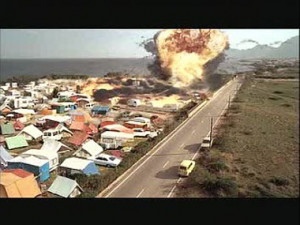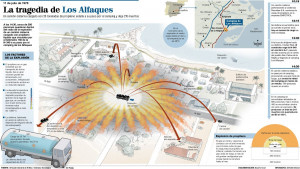A tanker truck loaded with highly flammable liquefied propylene experienced a fire and subsequent BLEVE (boiling liquid expanding vapor explosion) while directly in front of the Los Alfaques campsite, located between the road and the sea. 217 people (including the driver) were killed and 200 more were severely burned.
The truck, consisting of a tractor unit and a semi-trailer tanker had left a refinery 100 km north at 12:05 carrying 23 tons of propylene, nearly 4 tons over the maximum design load of the trailer (19.35 tons). The 50 year-old tanker driver was under instructions to take the smaller N-340 national road instead of the larger A-7 motorway when carrying cargo to Barcelona, in order to avoid the motorway toll. The N-340 was much narrower and more winding than the A-7, and also carried drivers directly through several densely populated areas.
At 14:35, while the truck was moving past the campsite, the truck swerved out of control and stroke the wall separating the campsite from the roadside, possibly overturning in the process. The cause of the road accident is unclear (blown tire ? tank already leaking as it approached the site? Hydraulic rupture of the overloaded tank ? ). In either case, the leaking tanker formed a cloud of gaseous propylene that partially entered the campsite and also drifted on the wind towards the discothèque to the northeast. The white cloud attracted the attention of campsite patrons, who approached the cloud with curiosity as it continued to spread. As the cloud began to permeate the crowded discothèque, it reached an ignition source and immediately flashed back into the tanker (UVCE), causing a fire that nearly instantaneously ruptured the weakened tank and ignited the full load of gas in a BLEVE.
At that time the campsite was crowded with nearly 1000 vacationers packed tightly in trailers and tents. The blast and fireball (which was estimated at over 1000 °C) destroyed everything cars, trailers and buildings within a 300-metre radius, gutting over 90% of the main camping area. The discothèque, which contained almost 100 people and was later determined to be the likely source of the ignition, was also razed, killing all inside. A total of 157 people died on site as a result of the initial explosion and the subsequent fires and explosions of cars and gas cylinders used by the tourists. He others died in hospital in the following days.
In the first 45 minutes after the disaster, the wounded were removed in an uncoordinated fashion with the help of other survivors using their own cars and vans. Locals also provided help and took the wounded to the hospitals. Ambulances and other emergency forces gradually arrived. The Civil Guard and the armed forces searched the devastated camp for survivors. It took 3 hours until the last wounded was removed and taken to hospital.
The official inquiry identified that the truck had been severely overloaded, and also lacked emergency pressure release valves, which are designed to help prevent a BLEVE in case of a fire. However, these valves were no longer mandatory in 1978, although they previously were. The truck was due for an inspection check-over in 1980, and it had passed the previous inspection.
The tank container was manufactured in December 1973 by a workshop from Bilbao. At that time, it did not meet the requirements for carrying flammable liquids, since it lacked emergency pressure release valves. Therefore, the tank had been used to carry other substances, some of which were highly corrosive. Tests on the remnants of the steel tank revealed microscopic stress cracks consistent with corrosion caused by previous loads of improperly overpressurized anhydrous ammonia. Combined with whether the tanker suffered an impact that caused additional structural damage, these factors likely led to the almost instantaneous rupture of the tank when the flames flashed back into the tanker. Even without safety valves, a structurally sound and properly filled tanker should have been able to maintain structural integrity in a fire long enough to at least allow nearby people to escape.
The inquiry also revealed that overloading of tankers was common practice, due to the lack of a meter to measure the amount of gas dispensed or an automatic shut-off device to prevent overfilling.
Following the accident, the pressure relief valves were mandatory on tanker trucks, the TGD regulations were changed (ban in densely populated areas, training for drivers ) and the coordination of emergency services was improved. The tragedy cost about 20 M euros to insurers.





